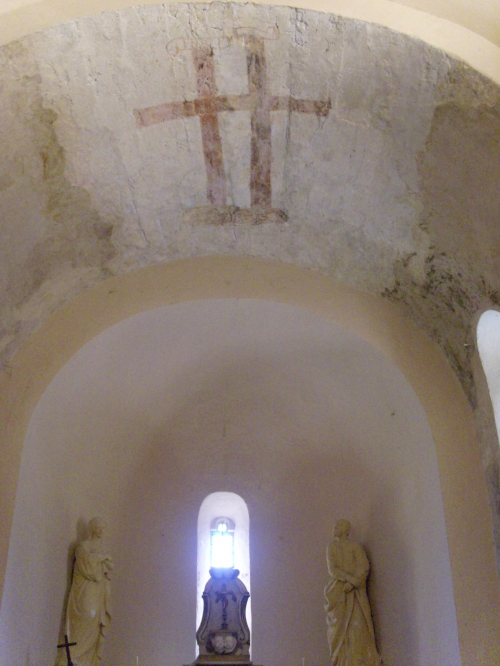Serres, Templar Village
Serres is on the D613 just a little to the north of Rennes-les-Bains.
It is particularly well-known for its well-preserved Roman bridge, on an old Roman road that connected Serres with Peyrolles, Luc-Sur-Aude and Alet les Bains. It crosses the river Rialiesse which joins the Sals a couple of kilometres to the west.

The Romans built their bridges with several arches like this, to make it easier for men and beasts crossing on shallow slopes rather than steep ones.
I also like Serres for its château that, it's said, communicated with Bérenger Saunière standing on the top of his Magdala Tower, and the Occitan café, holding many Occitan concerts throughout the year and serving good food in the summer.


I recently visited Serres in the Spring with my friend Kris Darquis who is writing a book about the Templars. She wanted to have a closer look at the Templar church in Serres. It is very old.


The church is orientated west to east, with a modern door facing south; the old door was on the north side and had a Templar cross above it. When first built it must have had a door at the west end and indeed, the interior lay-out confirmed this.


The Templars were an Order of Knights who protected travellers to the Holy Land and thus became immensely rich. They were accused of heresy (which meant that their goods could be seized) and wiped out about 1309, so this really was their church - way out in the Corbières wilds. Why? Was this route and this church much more important in medieval days?
Inside were more crosses and frescoes and also two fonts, both looking Visigothic in style, because the church had two doorways!


Here's a general view of the interior.
We all entered into a discussion about the age of the church; it could have been Carolingian, that is, around 800AD. If so I thought it might have been Visigoth before that, perhaps built on an older building; even a pagan temple?
We went to walk over the bridge. Beside it is commemorated the "Green Meridian." In 2000, the French made a great effort to have the Paris Meridian accepted instead of the Greenwich Meridian - and failed. So they designed the Green Meridian and placed "bournes" and had parties all along its route. And this passed from Paris through Serres and over - or under! - the bridge. (This has nothing to do with the imaginary "Roseline" of Pierre Plantard, that he said went through Rennes-les-Bains.)


On the far side of the bridge the road continued to Rennes-les-Bains, called Aquae Calidae at the time, which was a great centre for thermal baths in Roman times, to continue past the mines and join the mining-route east across the Corbières to the Mediterranean near Leucate.
My thoughts came back to the church. I know from my Roman road research that the Romans liked a travellers' halt before and after bridges so that people could refresh themselves and their servants and the horses, and that they built their roads in straight lines. So maybe it was coincidence that the church was there? This village has no centre, just a road running through. I expected to find the road on the bridge running straight to the church, but it didn't line up.
Then I saw that the Romans had built a bridge with a kink in it . . . the church door is directly opposite.
Hence my conclusion; on the site of the church was a Roman wayside travellers' halt to serve those coming from Rennes-les-Bains; it's known by all that the Roman road through Rennes-les-Bains was on the eastern bank of the River Sals, curving around Cardou to cross the Rialsesse into what is now Serres, then continuing to Luc to join the Roman road between Couiza and Alet-les-Bains, which ran on the eastern side of the Aude, not on the western side as does today's main road, the D118.
Now - must research the Templars!
Inscrivez-vous au blog
Soyez prévenu par email des prochaines mises à jour
Rejoignez les 97 autres membres






